Thank you for visiting! By the way… any links on this page that lead to products on Amazon and other stores/partners are affiliate links Aquarium Store Depot earns a commission if you make a purchase.
Are you looking to add some new fish to your angelfish community tank? Choosing the best tank mates can be kind of stressful, especially if you’re not sure that they will all get along. That’s why I’ve decided to put this guide together, so sit back and read along as we learn about 15 of the best angelfish tank mates.
Let’s get started!
Choosing Angelfish Tank Mates- What You Need To Know
Putting together a peaceful community aquarium can be a bit of a juggling act. You need to make sure every fish in the tank will be happy and get along. Angelfish make the perfect centerpiece fish for tropical community tanks, and it’s a good idea to start by building the tank around their needs.
All you need to do then is make sure that all the other fish are compatible with your angelfish and the conditions it prefers. Before we move on to some great angelfish tank mates, let’s take a few minutes to get to know the star of the show!
Temperament
Angelfish are very peaceful as far as cichlids go. If you have a breeding pair, expect them to become a little more aggressive, however, especially with their own species. Angelfish will also defend their nest site against any intruders after breeding.
Size
Angelfish grow pretty large, so there isn’t a whole lot of common aquarium fish that can eat your angels. A standard angelfish can reach 6 inches in length and 8 inches from top to bottom, and altum angels grow even bigger!
Despite their size, angelfish have pretty small mouths compared with other cichlids. They are generally safe around smaller fish, but they will eat any fish small enough to swallow whole. Fish fry and very small nano species should not be kept with angelfish.
Competition
Angelfish are not the fastest-moving fish, but they can be pretty competitive around mealtimes. Avoid keeping fish that are too slow to get their fair share of the food. It is best to watch your fish closely to make sure no one is getting out-competed.
Feeding different areas of the tank simultaneously and using a combination of floating and sinking foods can be very helpful to spread out the competition.
Parameters & Aquarium Setup
Before you can choose suitable tank mates, it’s important to understand the needs of your angelfish. Angelfish are tropical freshwater fish that prefer water temperatures between 78 and 84°F. This is on the warmer side so it’s important that their tank mates are comfortable in the same temperatures.
Angelfish require good water quality, with zero ammonia or nitrite in the water. They prefer water with a slightly acidic to neutral pH, between 6.5 and 7.8. The water flow in the tank should be gentle because angelfish are not very strong swimmers.
The 15 Best
After reading about how to select tank mates for your angelfish, you’re probably very interested to learn about some great options! I’ve put together a list of 15 awesome compatible species to help you choose. Check out our video below from our YouTube channel. More detail is provided in the blog post below.
Even though each species on the list will make a great addition to your angelfish tank, make sure you pay attention to the following important information:
- Scientific Name
- Adult Size
- Water Temperature
- Minimum tank size
- Care Level
- Diet
- Origin
- Swimming Level
Now let’s get started!
1. Corydoras Catfish
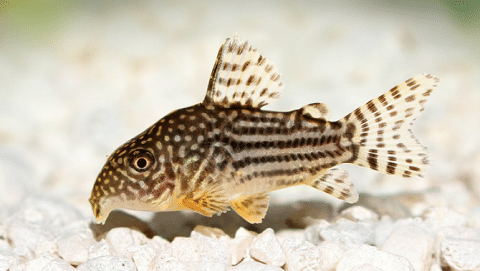
- Scientific Name: Corydoras spp.
- Adult Size: 1-4 inches
- Water Temperature: 72-82°F
- Care Level: Easy
- Diet: Omnivore
- Minimum tank size: 15 gallons for most species
- Origin: South America
- Swimming Level: Mostly bottom dwellers
Corydoras catfish, or cory cats as they are affectionately known, are awesome little bottom dwellers for tropical fish tanks. There are many different species to choose from in the aquarium hobby.
Corydoras catfish are social fish so make sure you pick up a group of at least 5 of the same species. They are incredibly peaceful little fish that will not bother your angelfish. The fact that they stay on the bottom means they will add another layer of interest and activity to your aquarium.
2. Ram Cichlids
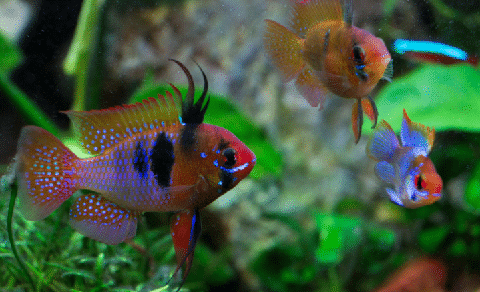
- Scientific Name: Mikrogeophagus ramirezi
- Adult Size: 1.5 inches
- Water Temperature: 80-86°F
- Care Level: Moderate
- Diet: Omnivore
- Minimum tank size: 15 gallons
- Origin: Venezuela, Brazil & Colombia
- Swimming Level: Bottom
Ram cichlids are an amazing dwarf cichlid with great colors. Unlike other South American cichlid species, these fish are peaceful and stay very small. Rams come in some amazing color varieties like electric blue and golden.
Ram cichlids are shy little fish that need pristine water quality. This means they aren’t a great choice for beginners, but more experienced aquarists will find these stunning fish make an awesome tank mate for their angelfish!
3. Molly Fish
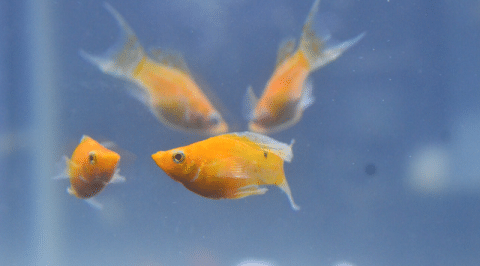
- Scientific Name: Poecilia sphenops & Poecilia latipinna
- Adult Size: 3-5 inches
- Water Temperature: 68-82°F
- Care Level: Moderate
- Diet: Omnivore
- Minimum tank size: 30 gallons
- Origin: South, Central, & North America
- Swimming Level: Midwater, top
Molly fish can make great tank mates for your angelfish. These hardy fish are livebearers that will breed readily in your aquarium. The fry usually get snapped up pretty quickly in community tanks but ask for females only if you would prefer them to not breed.
There are many great types of molly fish in the hobby, including sail fins and balloon varieties. Mollies prefer higher pH than most other tropical fish species, so they should only be kept in tanks with a pH over 7.5.
4. Kribensis
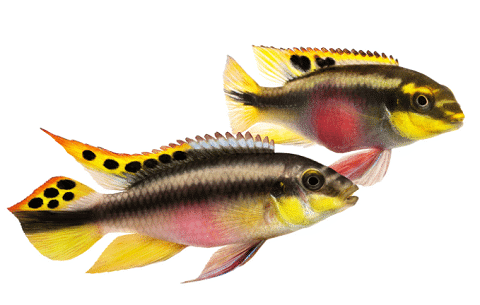
- Scientific Name: Pelvicachromis pulcher
- Adult Size: 3-4 inches
- Water Temperature: 75-81°F
- Care Level: Easy
- Diet: Omnivore
- Minimum tank size: 20 gallons
- Origin: Nigeria, Cameroon
- Swimming Level: Bottom
The kribensis is a stunning cichlid from over the ocean in West Africa. These small fish are happy in the same water parameters as angelfish, making them an ideal tank mate.
Kribensis are dwarf cichlids that spend most of their time at the tank bottom. These fish have a peaceful nature but can be aggressive towards other members of their own species, so it is best to keep them in a pair.
5. Rosy Tetras
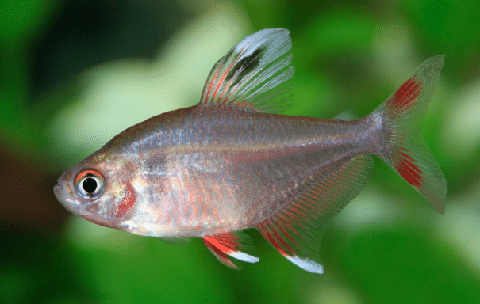
- Scientific Name: Hyphessobrycon rosaceus
- Adult Size: 1.5 inches
- Water Temperature: 75-82°F
- Care Level: Easy
- Diet: Carnivore
- Minimum tank size: 20 gallons
- Origin: Brazil, Suriname & Guyana
- Swimming Level: Mid-water
Rosy tetras are a little-known but awesome tropical aquarium fish. They are very small fish but they are safe to keep with larger angelfish because of their shape. It is best to keep 6 or more of these peaceful schooling fish in a community aquarium so that they can be more confident and behave naturally.
6. Zebra Danios
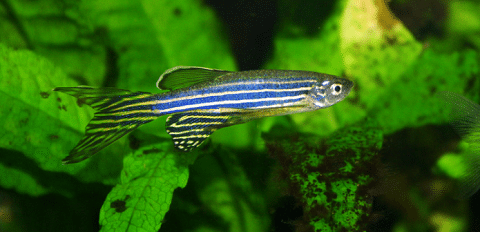
- Scientific Name: Brachydanio rerio
- Adult Size: 1.5-2 inches
- Water Temperature: 70-78°F
- Care Level: Easy
- Diet: Carnivore
- Minimum tank size: 20 gallons
- Origin: India
- Swimming Level: Midwater
Zebra danios are another species that make great tank mates for freshwater angelfish. They will add more activity and excitement to your angelfish tank without bothering their tank mates.
They are hardy fish that get their common name from their black and white striped bodies. Zebra danio fish are lively little creatures that are very peaceful and easy to care for.
7. Cardinal Tetra

- Scientific Name: Paracheirodon axelrodi
- Adult Size: 0.75-1.25 inches
- Water Temperature: 73-84°F
- Care Level: Moderate
- Diet: Omnivore
- Minimum tank size: 15 gallons
- Origin: Brazil & Venezuela
- Swimming Level: Midwater
The cardinal tetra is one of the most colorful tropical aquarium fish in the hobby. Apart from their colors, the great thing about these tetra fish is how peaceful they are! A school of 6 or more would make ideal tank mates for your freshwater angelfish.
8. Bristle Nose Plecos

- Scientific Name: Ancistrus spp.
- Adult Size: 4-5 inches
- Water Temperature: 70-79 °F
- Care Level: Easy
- Diet: Herbivore
- Minimum tank size: 15 gallons
- Origin: South America
- Swimming Level: Bottom dweller
Bristlenose plecos are really strange-looking bottom feeders that make one of the best angelfish tank mates. These bottom-dwelling fish hail from the Amazon river basin but have found a second home in aquariums all over the world.
Bristlenose plecos are very peaceful with other fish, but they should be the only member of their species unless you have a very large tank. There is also a Albino variety available.
9. Otocinclus Catfish
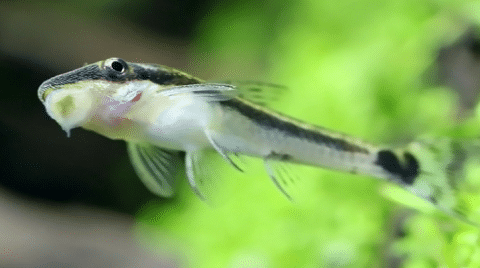
- Scientific Name: Otocinclus spp.
- Adult Size: 2 inches
- Water Temperature: 74-79°F
- Care Level: Easy
- Diet: Algae
- Minimum tank size: 10 gallons
- Origin: South America
- Swimming Level: All levels
Otocinclus catfish are amazing algae eaters that will help to keep your glass, hardscape, and plants clean. These hardworking tank cleaners look great too, and they can be very interesting to watch as they zoom around the tank looking for new feeding spots.
Otos need a good supply of algae to stay healthy, so make sure you wait until your tank is mature before introducing them.
10. Praecox Rainbow Fish
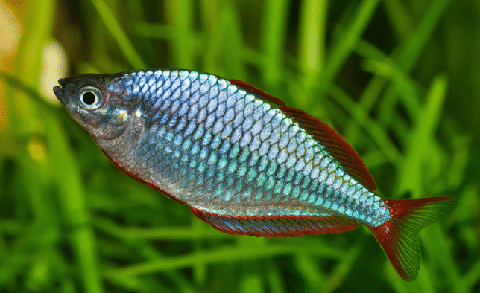
- Scientific Name: Melanotaenia praecox
- Adult Size: 2-3 inches
- Water Temperature: 73-82°F
- Care Level: Moderate
- Diet: Omnivore
- Minimum tank size: 15 gallons
- Origin: New Guinea
- Swimming Level: Midwater, top
Rainbowfish are another great schooling fish that can really help to liven up your aquarium. The praecox rainbowfish is just one of many rainbowfish that make great angelfish tank mates.
Rainbowfish need great water quality but are otherwise easy to care for. They should be kept in groups of 6 or more to bring out the best of their colors and behaviors.
11. Harlequin Rasbora
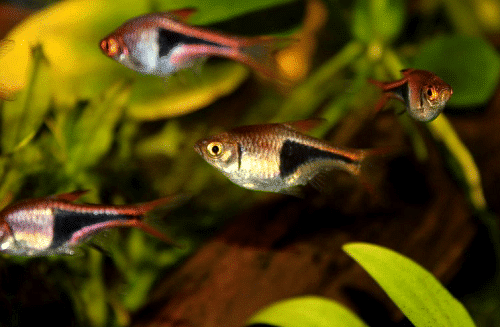
- Scientific Name: Trigonostigma heteromorpha
- Adult Size: 1.25-1.75 inches
- Water Temperature: 70-82°F
- Care Level: Easy
- Diet: Carnivore
- Minimum tank size: 15 gallons
- Origin: Southeast Asia
- Swimming Level: Midwater
These popular freshwater fish are recognizable by their bright orange color and the black triangular marking on their sides. They are very attractive fish that look amazing as they school together in the water column. Harlequin rasboras are very peaceful fish that add will vibrant color and activity to your angelfish community aquarium.
12. Cherry Barbs
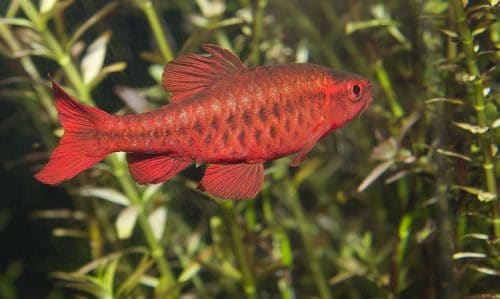
- Scientific Name: Puntius titteya
- Adult Size: 1.5-2 inches
- Water Temperature: 68-80°F
- Care Level: Easy
- Diet: Omnivore
- Minimum tank size: 15 gallons
- Origin: Sri Lanka
- Swimming Level: Midwater
Not all barb species make good tank mates for angelfish, but the peaceful cherry barb makes an excellent choice! These popular shoaling fish have a peaceful nature, making them a great community fish. Cherry barbs are a social species, so make sure you pick up a group of at least 6.
13. Rummy Nose Tetras

- Scientific Name: Hemigrammus rhodostomus
- Adult Size: 2 inches
- Water Temperature: 76-80°F
- Care Level: Moderate
- Diet: Omnivore
- Minimum tank size: 20 gallons
- Origin: Amazon river basin, Brazil & Venezuela
- Swimming Level: Midwater, top
Rummy nose tetras are schooling fish that make great tank mates for angelfish. They are active community fish that should be kept in groups of ten or more to see them at their best. The rummy nose tetra needs excellent water quality to really thrive so good filtration and regular maintenance are very important.
14. Nerite Snails
Horned Nerite Snails are excellent algae eaters for planted tanks.
- Scientific Name: Neritina spp., Vittina spp., Clithon spp.
- Adult Size: 1-1.5 inches
- Water Temperature: 72-82°F
- Care Level: Easy
- Diet: Algae
- Minimum tank size: 5 gallons
- Origin: Africa & Asia
- Swimming Level: Bottom
If you’re looking for some excellent tank cleaners for your angelfish community setup, nerite snails could be a perfect choice. These harmless aquarium snails have beautiful shells and do an amazing job of eating pesky algae in the tank. One of the best things about these snails is that they can’t breed in freshwater, so you never have to worry about them becoming a pest!
15. Black Skirt Tetra
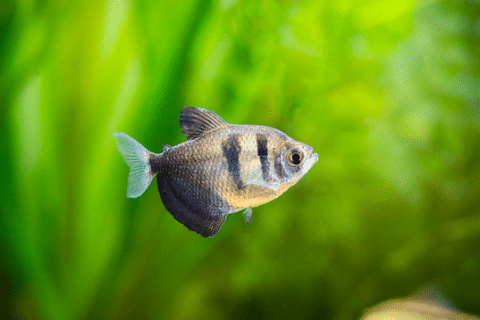
- Scientific Name: Gymnocorymbus ternetzi
- Adult Size: 2-2.4 inches
- Water Temperature: 68-78°F
- Care Level: Easy
- Diet: Omnivore
- Minimum tank size: 20 gallons
- Origin: Argentina, Bolivia, & Brazil
- Swimming Level: Midwater
The black skirt tetra is another peaceful species of schooling fish that works great with freshwater angelfish. These fish are also known as the black widow tetra but don’t worry, there’s nothing dangerous about them.
Black skirt tetras are active swimmers that should be kept in groups of 6 or more. They aren’t the most colorful tetras, but this can help draw attention to your centerpiece fish, the angels.
Bonus Tank Mates For Angelfish
The 15 peaceful fish in this list make awesome tank mates for freshwater angelfish, but there are many other options to choose from. Here are a few more popular species to consider:
4 Fish To Avoid
Now that you know 15 great tank mates for angelfish, let’s take a look at some common species that you should avoid:
1. Goldfish
The obvious problem with goldfish is that they are coldwater fish that prefer water that is 72°F or cooler. This is too cold for your angelfish, so the two species are not compatible. For the same reason, other coldwater fish like white cloud mountain minnows and dojo loaches do not make good angelfish tank mates.
2. Betta Fish
Use Coupon Code ASDFISH at Checkout
Betta Fish are one of the most beautiful varieties of freshwater fish available in the hobby. Easy to care for with plenty of varieties!
Bettas are slow-moving fish with long flowing fins. Keeping them with angelfish is risky because they can be easy targets for aggressive individuals. Some fish keepers might have had success, but I would not recommend trying this combo.
3. Semi-aggressive Barbs
Some aggressive species of barbs are notorious fin nippers and will not make good tankmates for angelfish. Tiger barbs, including green tiger barbs and Glofish barbs, should not be added to your angelfish community.
Other potential fin-nipping species like zebra loaches and head and tail light tetras should also be avoided.
4. Freshwater Shrimp
Freshwater aquarium shrimp are a great addition to small tanks and aquascapes. Peaceful, full of personality, and colorful. Many varieties are available.
Angelfish will not think twice about snacking on freshwater shrimp. Some shrimp might survive in a heavily planted tank with loads of hiding space, but you’ll probably see their population decreasing pretty steadily!
Angelfish Community Aquarium Setup
Setting up an awesome angelfish community tank could be as simple as introducing other fish to your existing aquarium. If you don’t already have an angelfish community tank, here’s what you need to know:
Introducing Aquarium Companions
It’s really important to have a backup plan in case your angelfish don’t get along with their new tank mates. At the end of the day, each fish has its own personality, and what works for a hundred other fish keepers might not work in your tank.
I recommend setting up a small, inexpensive aquarium separate from your angelfish community tank. This tank only needs to be a few gallons, with a small filter and a heater. If war breaks out after you introduce tank mates, they can always be moved into this tank temporarily until you return them to the store or make another plan.
A tank like this has other great benefits too. New fish can be quarantined in this tank before going in with your angelfish to prevent spreading any diseases to your other fish. It will really come in handy down the line if any of your fish get sick and need a hospital tank.
If you have some issues with angelfish aggression, check out this video below by Hardyaquariums. His 5 tips are summarized below:
- Balance the number of males and females
- Buy dither fish for your angelfish to chase around (like Danios)
- Get a bigger aquarium that is tall
- Make hiding spaces for your angelfish for them to claim territory
- Feed your angelfish well – Well fed fish will not fight as much
Aquarium Size
Angelfish can be kept in tanks as small as 29 gallons. Some fish keepers even go as low as 20 gallons, but I would recommend going larger if you can. 55 gallons or larger will allow you the room to create a thriving and busy angelfish community with loads of amazing tropical tank mates.
One important thing to remember when picking out a tank is the angelfish body shape. These fish have really deep bodies that are taller than they are long. Tall tanks are therefore a better choice than long ones.
Heating
Angelfish prefer warm water between 78 and 84°F. You’re going to need an aquarium heater to maintain this temperature in your tank. Make sure the heater you buy is rated for the size of your aquarium.
I recommend using a thermometer if your heater does not have a display, this makes monitoring the water temperature in your tank much easier. Heater control is even better if it’s within your budget.
Filtration
Maintaining a healthy and beautiful angelfish community aquarium is almost impossible without good-quality filtration. There are so many different types of aquarium filters on the market, however, so which type should you choose?
Aquarium filters come in different sizes, but the amount of water the manufacturers claim they can filter is just a guideline really. I recommend opting for a slightly larger filter if it doesn’t take up too much room. Canister filters are ideal for this purpose because they can be kept out of sight in the cabinet under your tank.
The Pro's Choice
The top choice among professional aquascapers. German engineering and equipped with an intregrated heater.
Hang on back and internal filters work great too, just make sure the filter isn’t producing too much current. Remember, angelfish aren’t very strong swimmers! A filter with an adjustable output is very useful for dialing in the perfect flow.
Aquarium Maintenance
Aquarium maintenance is very important for maintaining happy and healthy fish in your angelfish community tank. Here’s what you need to do:
- Use a test kit regularly to monitor your water parameters. Your nitrate levels should not go over about 30 parts per million, and ammonia and nitrite should always read zero.
- Remove any physical waste and uneaten fish food from the bottom of your tank with a gravel vacuum.
- Perform a partial water change 2-4 times per month to keep your nitrate levels safe.
- Follow the recommended maintenance schedule for your filter model, and rinse out the media when necessary.
Feeding
Angelfish are not that picky about their diet. These fish can be fed a staple diet of dried food like pellets (like Fluval Bug Bites) and freeze dried foods. Supplement this diet with frozen or live foods like brine shrimp and blanched veggies like zucchini for a complete and balanced diet.
Fluval bug bites tropical fish is an excellent staple food for most tropical fish. Made of black solider fly larvae
Not all of the tank mates in this list will thrive on this diet so it’s important to cater to each species in the tank. Bottom dwellers like cory catfish, for example, should be given sinking pellets or tablets. Algae eaters like otocinclus catfish will need a steady diet of algae, but you can suppliment this algae wafers.
Avoid overfeeding your fish because uneaten food can spoil and cause dangerous ammonia spikes. Feeding your fish small amounts of food more than once a day is a good way to avoid this. Another good tip is to provide only enough food for the fish to finish in a minute or two.
Live Plants
Angelfish thrive in a heavily planted tank. Fortunately, so do all the other fish species on this list! Many fishkeepers think you need very deep pockets and a degree in botany to grow live aquarium plants, but it’s actually really easy to get started.
If you’ve never grown live plants before here are a few things to know:
- Plants need light to grow. Different species need different amounts of light, but there are many aquarium plants you can grow under regular aquarium lighting.
- Plants need nutrients. Different types of plants get their nutrients in different ways. Some types of plants can be grown without soil or substrate and get their nutrients from liquid fertilizers. Other types of plants need nutrients at their roots.
- Plants need carbon dioxide. All plants need CO2 to grow, but some species need more than others. If you want to get serious about growing plants, you’ll probably want to invest in a CO2 injection system. If you’re just starting out, choose low light, low CO2 plants.
You’ll find loads of great articles on caring for different plants on this website, go ahead and check them out. Growing live plants is fun, and your angels and their tank mates will thank you for it!
Substrate & Decorations
The substrate is the sand or gravel at the bottom of the aquarium. There are so many different types available that it can be hard to pick one! The color is up to you, but most aquarium fish seem to prefer darker colors.
Sand or gravel can work great, just make sure they are aquarium safe and that you wash them out thoroughly before setting up the tank. There are some great aquarium soils available for planted tanks. Avoid these unless you plan on growing a lot of plants.
Decorations can turn an average-looking fish tank into an amazing one. As with the substrate, you can use your creativity and decide whether to go for a natural look or create a unique scene. Again, its really important that anything you put into the tank is clean and aquarium-safe. Natural decor like driftwood or aquarium rocks are great if you want to try build to an aquascape style
Where To Buy
Most of the angelfish tank mates in this list are common species that are easy to find in most aquarium stores and pet shops. If you don’t have a decent local fish store where you live, you can always go ahead and order your fish online. Buying online will also give you access to rarer breeds.
FAQS
What Fish Can Be Kept With This Type of Fish?
Popular aquarium fish like cory catfish, otos, rainbow fish, and many types of tetras can be kept with angelfish. There are plenty of other fish species that make great angelfish tankmates too. The ideal tank mates are peaceful fish that enjoy the same water parameters.
What Fish Do They Not Get Along With?
Angelfish should not be kept with aggressive fish or fin nippers. Avoid larger cichlids like oscars and small aggressive fish like tiger barbs.
Are They Good Community Fish?
Angelfish make great peaceful community fish if they are kept with the right tank mates. They can be a little aggressive when breeding but are generally safe to keep with other peaceful fish that enjoy the same conditions.
How Many Can Be Kept Together?
Angelfish can be kept in pairs or small groups of 4-6 individuals. The number of angelfish you can keep together will also depend on the size of your tank. These fish can get territorial when breeding, so it’s important that the non-breeding angelfish have enough space to avoid conflict.
Final Thoughts
Angelfish are easily one of the most beautiful species for freshwater aquariums and they make great community fish too. With the right tank mates and knowledge, any fishkeeper can create a thriving tropical community in their own home.
So what are you waiting for? Go ahead and start planning your own angelfish community today!
Do you have an angelfish community tank? Tell us about your favorite angelfish tank mates in the comments below!
- About the Author
- Latest Posts
I’m thrilled that you found Aquarium Store Depot! Here you’ll find information on fish, aquariums, and all things aquatics related. I’m a hobbyist (being doing this since I was 11) and here to help other hobbyists thrive with their aquariums! I adhere to a high quality Editorial Process and Review products with real life field usage and practical analysis.

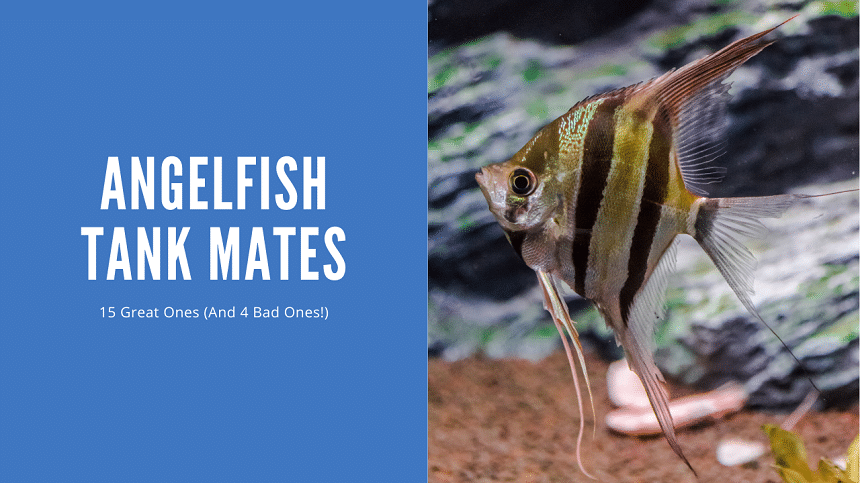

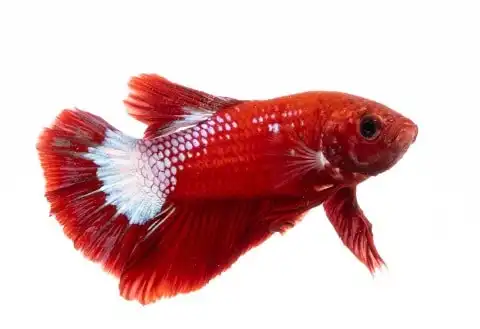


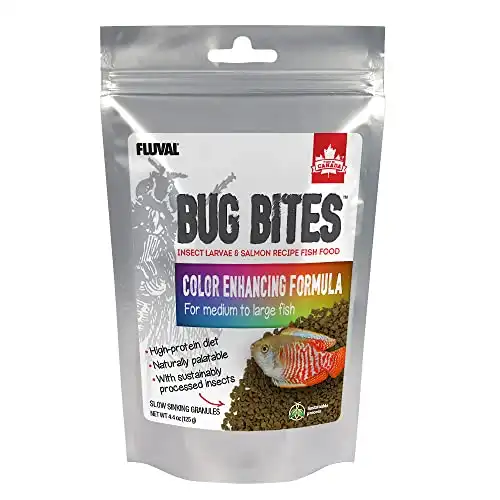




I have a 20 gal tank with Tetra Glo fish and Plattys. Is it safe to add to 2 Angels as well?
Hi there. The angelfish would be too large for a 20 gallon tank. You would need at least 29 gallons or better 40 gallons.
I am just preparing my 30gal tall octagon tank for Angel’s. I saw today koi Angel’s they were pretty as well as the dark black. I’m thinking 3 and nitrite snails and corys?
Sounds good, but you may need a bigger tank for the angels
Can clown fish live with freshwater angels?
No. They are saltwater fish.
I’m thinking about adding an angelfish in with our two dragon eels. Is this a good or bad idea? I’m not able to find any research info. on this
Hi there. The only dragon eel I’m aware of are the saltwater types. Is this is a freshwater or saltwater question. If freshwater, you could attempt a fire eel
We are enjoying platys and dwarf guaromis with our angelfish. They all get along very well and it’s a nice variety of colors, shapes and sizes of fish.
What’s a good number of angels for a 75 gallon tank, whilst still being able to have other community fish? There would be no other fish bigger than large tetras.
I just had this great idea today. I live on SSI. But, I think I would love an angelfish community tank. Can I have 4 in a 20 gallon tank ? Vivian
That’s going to be too small for that many angels. You can try smaller schooling fish if that works for you.